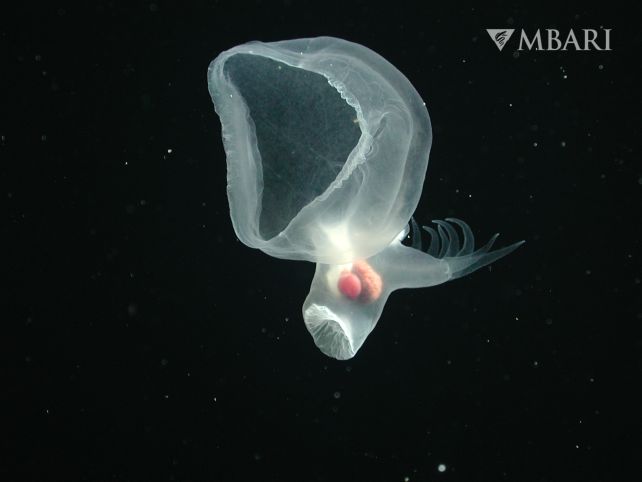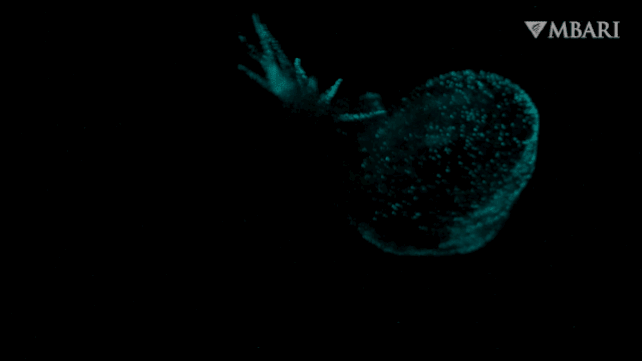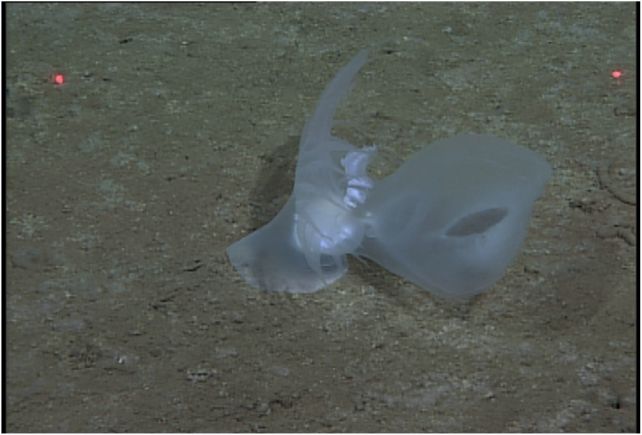[ad_1]
Picture yourself sinking, slowly, beneath the waves.
As you fall, the Sun becomes smaller, and dimmer, and dimmer still. The cold waters crush in around you as the pressure increases. Now you’re in complete darkness, so deep that the sunlight can’t reach you. Then, astonishingly, you see a flicker of light, from a creature unlike any humans have seen before.
It’s a nudibranch, recently discovered swimming freely in the water column lit by a bioluminescent glow, adorned with a billowing hood, by researchers from the Monterey Bay Aquarium Research Institute (MBARI) in the US.
This is Bathydevius caudactylus, the first known nudibranch of its kind: living not in shallow waters, or on the seafloor, but more than 2,200 meters (around 7,220 feet) below the surface of the Pacific Ocean in the bathypelagic zone, out in open water.

“Most nudibranchs live on the bottom in shallow water, so it was very surprising to find a nudibranch so deep in the water column and far from the bottom,” MBARI marine scientist Bruce Robison told ScienceAlert.
“We knew of a few species that live on the deep seafloor but none had ever been reported in deep midwaters.”
Sea slugs of the nudibranch order are among the most charismatic of the molluscs. They’re often brightly colored, with ornate appendages and patterns. They’re often found on reefs, where some species munch coral; others eat algae, sponges, anemones, jellyfish, or even other nudibranchs.
They’re diverse, and versatile, but that versatility was thought to be restricted to a certain range. This is one of the reasons why MBARI researchers nicknamed the animal “mystery mollusc” when they came across it while piloting the remotely operated research vehicle Tiburon at a depth of 2,614 meters.

“When we first filmed it glowing with the ROV, everyone in the control room let out a loud ‘Oooooh!’ at the same time,” Haddock says. “We were all enchanted by the sight.”
The creature they saw had a foot like a sea slug, but also a large, gaping hood, and a tail that was fringed, appearing like fingers undulating in the current. Through the ethereal, translucent skin on its body, roseate internal organs can be seen. And, when the ROV approached, and the creature felt threatened, it lit up with a bioluminescent glow.
This behavior seems defensive: on one occasion, the researchers saw one of the tendrils on the slug’s tail glow steadily while rotating, eventually detaching and floating free, similar to the way a lizard might drop its tail in a bid to distract a predator.
In total, the researchers encountered 157 individuals of the species during dives between 2000 and 2021, 32 of which they studied in detail, and 18 of which they collected for further study in a laboratory setting. This study included a genome analysis, which allowed them to place the strange creature as a nudibranch – but one so different from all other nudibranchs that it required the creation of a new family, Bathydeviidae.

“The most exciting aspect of this discovery,” Robison told ScienceAlert, “is that we were able to make the most comprehensive initial description of a new deep-sea species ever presented (anatomy, respiration, bioluminescence, reproduction, feeding, genetics, behavior).”
Observing Bathydevius in its natural habitat, the researchers watched the animal use its voluminous hood to capture prey, indicating a diet rich in crustaceans. Lacking the raspy tongue-like appendage seen in most other nudibranchs, Bathydevius instead swallows its food through a mouth in the back of the hood.
Two other species of nudibranch use hoods similarly, but they are very distant from Bathydevius in the nudibranch family, suggesting that the trait evolved independently in the newly discovered species.
The nudibranch, like others of its free-floating kind, is hermaphroditic. On one occasion, the researchers were lucky enough to observe parts of Bathydevius‘ reproductive strategy: at a depth of 2,755 meters, two individuals had anchored themselves to the seafloor to undertake the process of laying their frilly ribbons of eggs. Other individuals were seen clinging to the seafloor in a similar manner, at depths up to 4,009 meters.
In another instance, one of the captured individuals was ready to release its eggs; it did so in the tank, releasing a ribbon that drifted and then attached to the floor of the tank. After three days, the mucus matrix of the ribbon dissipated, and the eggs developed into larvae.
It’s the most complete study of a new deep-sea species conducted to date – and one that suggests we may have been too conservative in our assumptions about what the natural world is capable of.
“Bathydevius is radically different from all other nudibranchs because it is well adapted to live in a very different habitat; evolution has overcome the challenges of survival where it lives, and it is very well-suited to succeed there,” Robison said.
“This tells us that nudibranch evolution is far more flexible than we had believed it to be.”
[ad_2]
